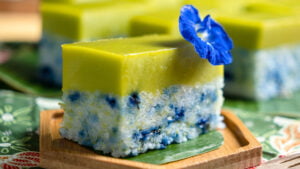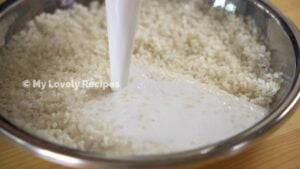I love eating Nyonya Kuih, especially those with glutinous rice. But I have an upset stomach and often have indigestion after eating. So we researched a Nyonya Kuih that uses Japanese rice instead of glutinous rice to relieve the digestive system of the stomach – Glutinous Rice With Pandan Custard (Kuih Seri Muka / Kuih Salat).
The Making Of Bottom Layer
The part we use to make the bottom layer is Japanese rice. Although it is short, it tastes oily and glutinous, and its stickiness is also very good. It is a good choice to replace glutinous rice to make Nyonya Kuih. If you like to eat glutinous rice, you can refer to our previous Pulut Taitai and Pulut Inti, which use 2 different ways to make the glutinous rice Kuih.
The coconut milk is too thick for cooking rice, it will be difficult to be absorbed, so I use water to dilute it. You can also just use normal coconut milk and add half a teaspoon of salt to taste. Mix well before pouring into the rice. Stir a little with chopsticks to mix the rice and coconut milk evenly. Also, steamed rice can be cooked more evenly on a plate than in a bowl.

Butterfly Pea Flower
I will pull out the green part of the butterfly pea flower because if it is used for cooking, it will be a little hard and will affect the mouthfeels. Then, bury the butterfly pea flower in the rice in several places. This way the cooked rice will have an unevenly natural shade of color. After that, cut a pandan leaf into small pieces, spread it evenly on the rice, and then put it in a preheated pot and steam for 20 minutes.
You can prepare the mold during steaming. I used a 6″ removable bottom mold and put a banana leaf on the bottom. After the rice is steamed, turn off the heat and take it out. First, remove the pandan leaves and stir to distribute the color. Finally, scoop the rice into the mold and press with a spatula to firm it up. Otherwise, the Kuih base will loosen easily. The steamed rice in this recipe is distinct and chewy. If you like a softer texture, you can add more water to cook rice.

The Making Of Top Layer
Add pandan leaves to a food processor, then add water and blend to make pandan juice. After it, use a cloth to filter out the fibers of the leaves, or you also can use the finest strainer. Combine all the ingredients used to make the top layer, then stir well before straining into the pot. Make sure there are no lumps, otherwise it will affect the outcome.
Before you start to cook the custard, remember to preheat the pot and put the blue pea flowers rice in it. While the custard is cooking, keep it low heat and stirring constantly. The purpose of cooking it to thicken is to prevent it from penetrating the rice and also to allow the powder and liquid to combine together. Then the powder will not be sinking when steaming. The batter will start to thicken in about three minutes, turn off the heat as soon as you notice lumps on the bottom. Then keep stirring to make it smooth, and strain it one more time into the mold. If there are small bubbles on the surface, poke them with a toothpick or scoop them with a spoon.

Simple Tips for Steaming
When closing the lid, make a slit about the size of a chopstick, turn on the high heat first, turn to medium heat, and steam for 30 minutes after the water is boiling. The seam on the lid is to allow the steam to have a place to release, so that it will not accumulate too much in the pot. And the tilting of the lid is to allows the water vapor to flow down obliquely. Both are simple ways to reduce steam dripping onto the surface of the Kuih.
After steaming, you can poke it with a toothpick. If it doesn’t stick to the toothpick, it means it’s done, take it out and let it cool for about 15 minutes before unmolding. First, use a spatula to slowly cut the edges, and then use a cup to push the bottom of the mold. Once completely cool, use a greased plastic knife to cut into the size you like. If you cut the Kuih before cold down completely, the custard layer may not be fully set yet. This will cause the finished product to be less beautiful!

Eggless Custard Layer
The key is the ratio of the flour. I have tried several versions. If there is more tapioca flour, it will taste very chewy, and if there is more all-purpose flour, the mouthfeels will be softer. It looks like Kuih Kosui when eaten with shredded coconut! In addition to the egg-free version, this Nyonya Kuih with coconut milk is not suitable for storage for many days. If there are not many members in the family, you can make an egg version in a small bowl.
If you like our Kuih Seri Muka recipe, please share it with your relatives and friends~ I wish you a happy life!


Kuih Seri Muka
Please Click 1-5 Star to Rate This Recipe
Print Pin Comment & RateINGREDIENTS
💙Bottom Layer
- 300 g Japanese Rice
- 150 g Thick Coconut Milk
- 150 g Water
- 30 pcs Butterfly Pea Flowers
- 0.5 tsp Salt
- 1 Pandan Leaf
- Banana Leaf
💚 Upper Layer
- 50 g Tapioca Flour
- 30 g All Purpose Flour
- 100 g Pandan Juice Use 40g Pandan leaves and 120g water to make juice
- 100 g Caster Sugar
- 200 g Thick Coconut Milk
- 0.5 tsp Salt
- 3 Eggs about 150g egg liquid
💚Upper (vegan)
- 40 g Tapioca Flour
- 110 g All Purpose Flour
- 120 g Pandan Juice Use 50g Pandan leaves and 140g water to make juice
- 120 g Caster Sugar
- 250 g Thick Coconut Milk
- 0.5 tsp Salt
INSTRUCTIONS
- Wash the Japanese rice and put it on a plate. Mix the thick coconut milk, water, and salt evenly, then pour it into the rice and stir well with chopsticks.

- Put the blue pea flowers into the rice in different places, and put the pandan leaves on top.

- Then steaming on high heat for 20 minutes, remove the pandan leaves and stir the blue rice with chopsticks to spread out the color.

- Put the banana leaf at the bottom of the movable mold, press the steamed rice firmly, and then put it in the pot to keep warm.

- Blend pandan leaves with water into a juice with a food processor, filter out the fibers with a cloth and extract the juice.

- Put the all-purpose flour, tapioca flour, thick coconut milk, salt, caster sugar, and pandan juice into a measuring cup, stir well and strain into a pot.

- Cook on low heat until it is a little sticky, then filter it again and pour it into the blue rice.

- Turn on high heat first. After the water is boiling then turn to medium heat and steam for 30 minutes. Leave a seam of the lid can reduce steam dripping onto the Kuih.

- After steaming, let it cool before demolding, then use an oiled plastic knife to cut into the size you like and enjoy.

INSTRUCTIONS VIDEO
NUTRITION

We are Penangites who love to COOK & EAT, so we are sharing the food we love with you. Know more about us…









